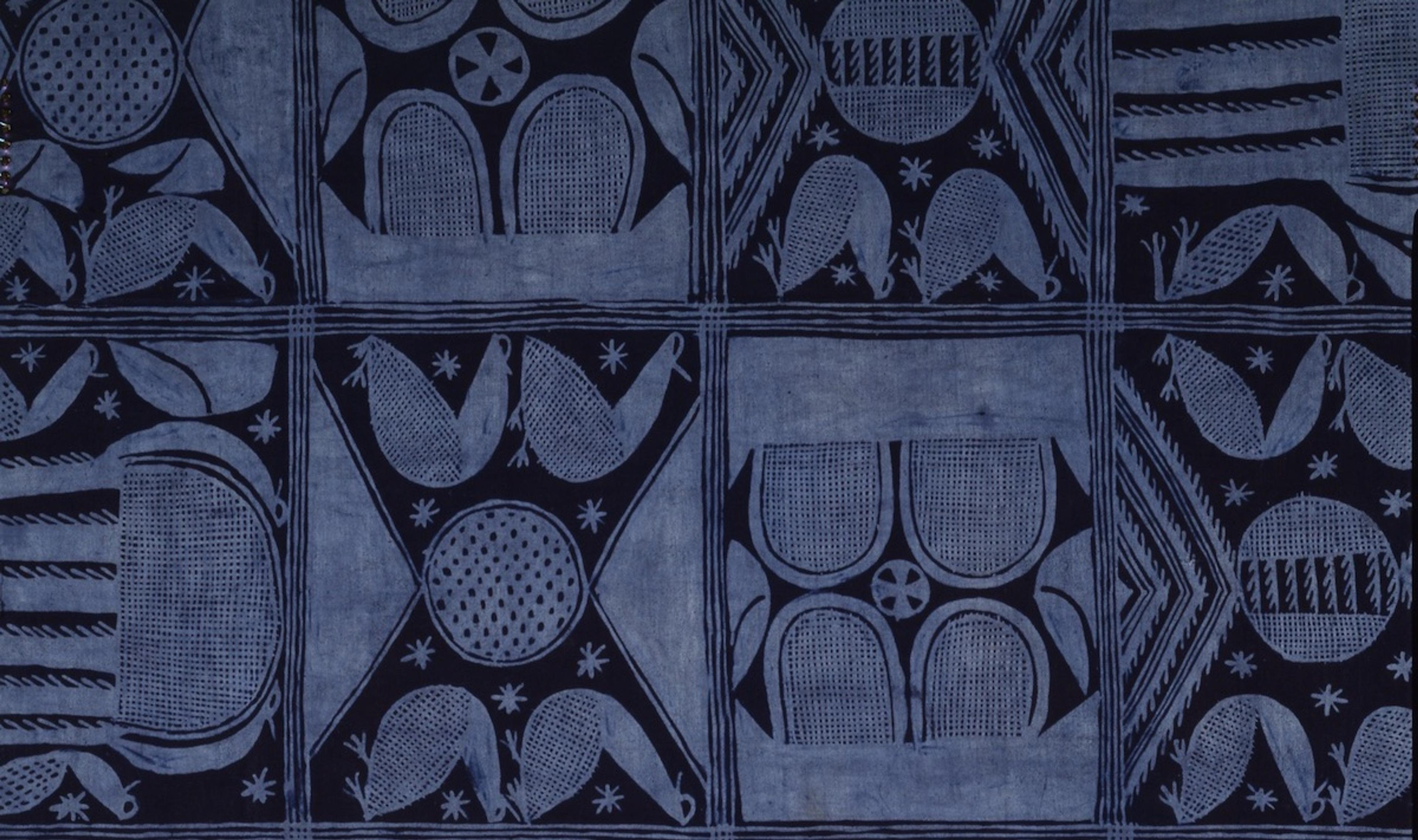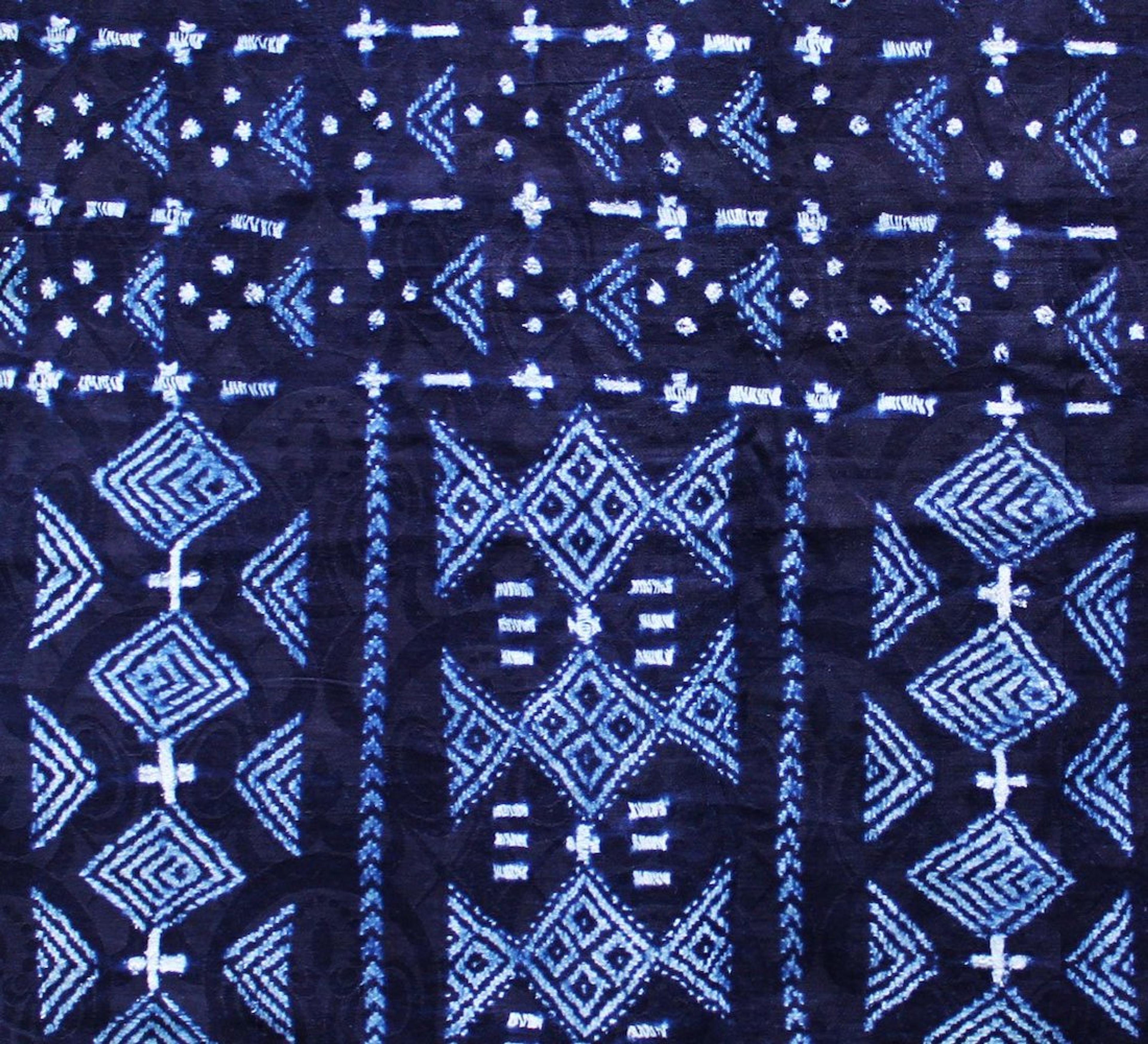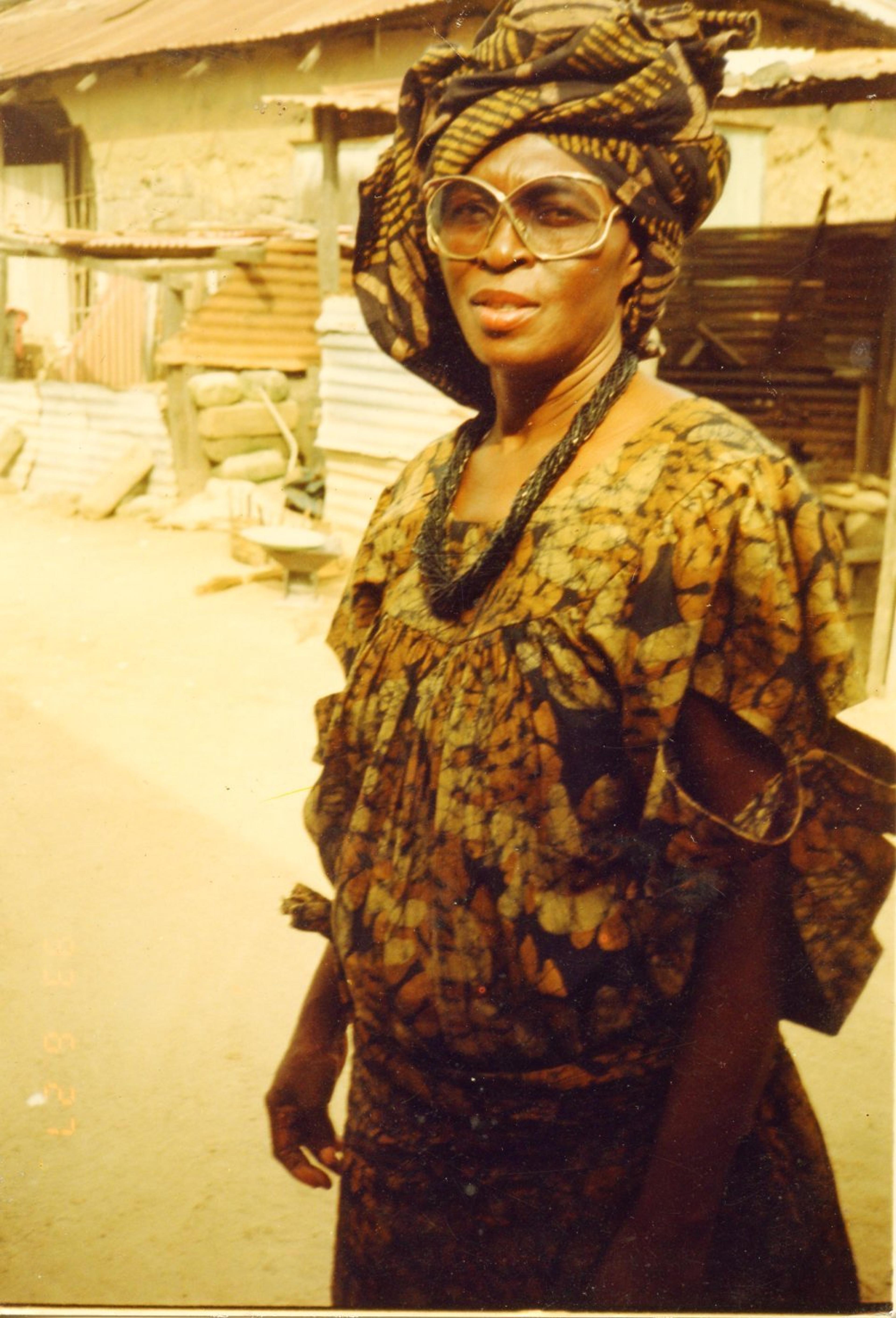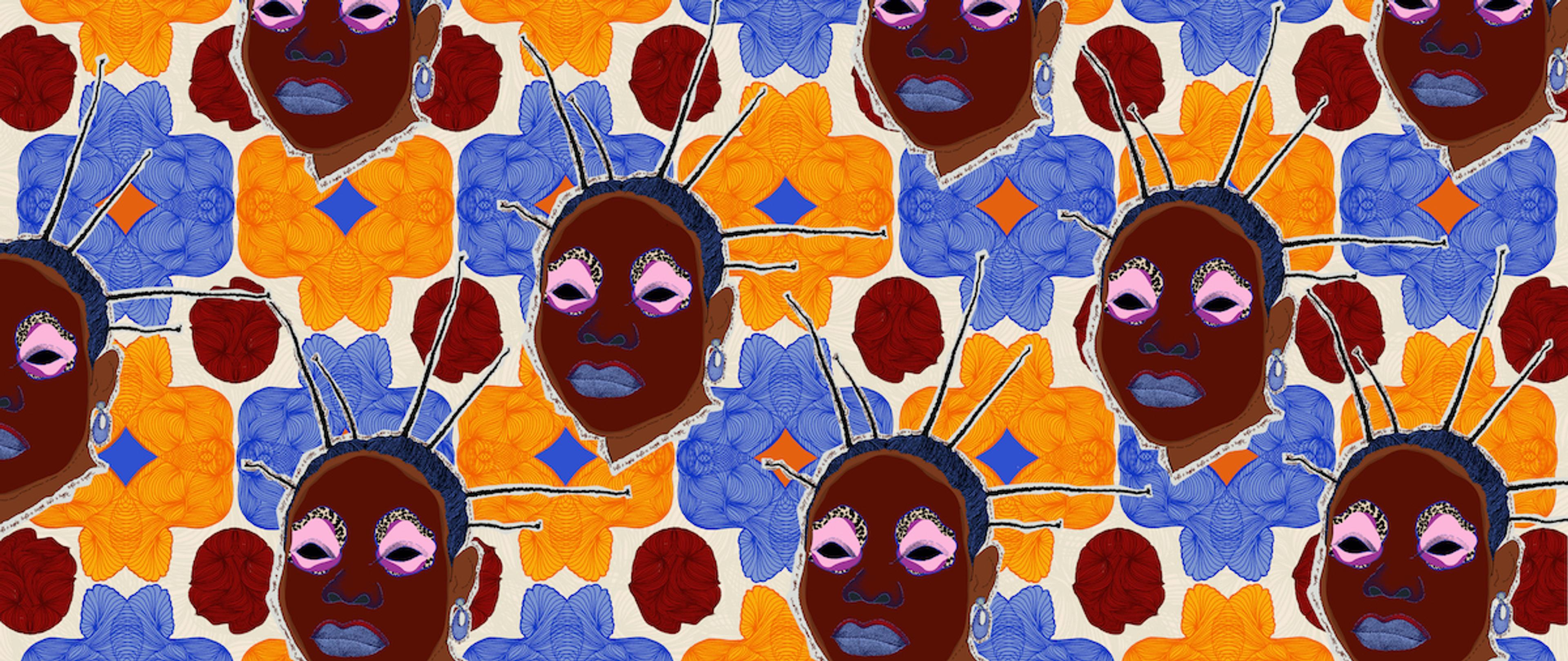Uncovering a Women’s History of African Indigo

For the length of indigo’s history, African women across the continent were central to the trade.
by Catherine McKinley
July 13, 2023
Catherine McKinley is the author of The African Lookbook and founder of the McKinley Collection, a piece from which is displayed in our exhibition Africa Fashion, on view through October 22.
As I walked home along the usually-crowded road from one of Accra’s famous night markets, now hidden in darkness, ignorant that the streets had emptied out of well-founded fear of falling electrical wires and swollen gutters, a woman called to me from underneath a nearby canopy.
“Sister, you are no more at England. Come out of the rain!”
I crossed to her tiny provisions shop, lit by kerosene lamps; in a flash of light, I glimpsed her looking hard into my eyes. She grinned then, as if something had been confirmed, and ushered me inside, introducing herself as Aunty Eurama. “Come and sit down.”
I felt a presence behind me—a stool was pressed against the back of my legs—and then I felt a surprising heat. A wild orange and green spider’s-web–patterned wrapper—those essential two yards of cloth that West African women interchangeably use as a sarong, a baby carrier, a matching complement to their dress, or headgear—dropped over my rain-soaked dress, still giving off steam from a charcoal-heated iron.
All of those lessons in death and mourning, in women’s struggles for autonomy, were lessons in the ritual and esoteric life of indigo.
A young woman at a sewing table giggled shyly as she moved the iron over my wrapper’s mate. From the back of the shop, a child emerged in a peacock-blue taffeta dress with heavy lace at the neck, worn from many washings and buttonless along the length of its back. She set a cup of tea before me. A bush dog, large and white, resembling a sheep, settled his head against my foot. We sat in silence while the rain chorused against the tin roof.
*
I had arrived in Ghana three months before on a Fulbright with a suitcase full of books and research notes. I had the luxury of a well-funded year to embark on what would become a several-year journey through eleven West African countries in search of indigo: its history in West Africa; the art of dyeing, which was fast disappearing; its meaning in Yoruba, Baule, Dogon, and other religious practices, like Vodun and Sufism; and its cosmetic, medicinal, and metaphysical powers.

In the many books on indigo’s world heritage, Africa was always sidelined to a chapter. In fact, African indigo—native to areas of Mali, Guinea, Ivory Coast, Senegal, and Nigeria in particular—had been particularly coveted in world markets for millennia. Indigo had been one of the so-called hidden commodities that powered the trans-Saharan and trans-Atlantic trade routes, most notably the trade in human captives along both conduits. In slavers’ log books, lengths of indigo cloth often appear as currency in the exchange for human chattel.
The most captivating history, for me, came with the discovery that for the length of indigo’s history, African women across the continent had been central to the trade, acquiring unparalleled wealth and political power by working and trading the rare, refulgent dye and the commodities spun from it. There was evidence of the women indigo dyers using their wealth and power to overturn colonial legislation, organize vast market associations, and, in one notable case, depose a king. But this included roles that supported ongoing wars between kingdoms (both in collusion with, and in resistance to, colonial powers), concubinage systems (which grew from war spoils, providing labor in a lucrative international textile trade) and, most devastatingly, the supply and trade of captives in the Triangular Trade. In the photographs and postcards from the late 1800s and early 1900s that I collected, we see evidence of these women, their prestige imprinted on the deep blue cloth they wear, sometimes with indigo paste covering their hair beneath their head wraps—a sign of power and nobility.

In these first months, I was consumed by a sense that I was failing. The university where I had set up base was shut down for weeks by a strike. I’d exhausted the city’s few small embassy libraries, filled mostly with trade and governance books. My days had become more and more unstructured; purposelessness was beginning to cloud them like the slow-filtering Saharan haze of an early Harmattan (interrupted this night by the rains). The university botany labs and government agricultural centers were sympathetic to my quest, but they could not produce one tiny indigofera leaf. I navigated the city in search of signs—photographing any wearer, any suggestion of the history I sought—but I felt cut off from everything.
In time, I stood to go, the anxious feelings crowding my thoughts. “Ei, why? I brought Coke to serve you,” Aunty Eurama said. “There is yam on the fire. Stay for some time! Someone can lead you home. We know the house. We have been watching you every day, walking to the main road with your big book bag.”
It was a familiar seduction in Accra in that era: invitations to sit, to eat, to be a sister or friend; the sudden tuck of someone’s hand in the street; affection, sometimes gentle and sometimes groping. Accra communitas. A friend had said, once, that Accra—until globalism—was “a society much more than it is a city,” suffused with a sense that you are welcome everywhere. It was hard to resist an invitation with a real sense of care.
I returned home later that night, well-fed, with a borrowed sweater and a pair of slippers, my waterlogged shoes left drying by Eurama’s cookstove. Checking the sweater’s pockets out of habit as I hung it by the door, I discovered a tiny piece of blue cloth, patterned like the Milky Way, tied around something hard and as long as a packet of chewing gum. Indigo.
Guinea indigo. Famous for its blue-black color and designs that add layers of patterning to the intricate weave of the brocade often used. The kind that, a decade before I started this research, it had been possible to find in the markets and with traders. Since then, most indigo cloth from Guinea and Nigeria—two particularly famed dyeing centers—had been replaced with synthetic copies and Asian and East African factory imports. Hand processed, designed, and dyed indigo remained desirable, but was out of reach of most buyers.

The next day, Eurama laughed a kind of outlaw laugh as I handed her what I’d found. She unwrapped it to reveal a tight wad of cedi notes folded over a key. I blurted something excitedly about the indigo. “Yes o,” she laughed. “It’s a blue color. But this is money matters!”
Later she would disappear in the house and merge with a beautiful kaba and slit, Ghana’s national dress, made from that blue Milky Way cloth. “This is the dress I wore to the outdooring—the naming ceremony and customary rites—for my lastborn,” she said. That ceremony marked the time that the child would be considered safely of this world—healthy and not a spirit taking temporary form in the living—and their name would be shared as they were presented to the world.
Cloth is a protection—physical and metaphysical. It is worn, of course, and used as a cover for many things—whether simply precious, or needing care, or privacy, or honor. Blue and white are God’s colors, whether Christian, Muslim, of the shrines, or many pre-colonial African religious pantheons. They summon and honor whatever realm holds your belief. Eurama was making my book-learning material.

From that day, I stuck to Aunty Eurama. I decided to sit out the university strike and the coming holidays and enter the school of her shop. With a steady stream of customers to her niece’s sewing table inside, I became inducted into the rigors of Accra fashions, where most clothing in those years was still made to order, and I began to pitch in: sweeping, stacking shelves, and tying “ice water rubbers,” small plastic bags filled with tap water for drinking. Eurama would insist that I relax; I would resist, telling her I couldn’t just sit down and be useless.
“My dear, never say that—you are good for business!” she said. “ ‘The stranger is God’—it is one of our sayings. Everyone wants to come and look at the stranger’s face. And then you are from New York—hei! The shop past the junction complained that I am taking all of their customers. You see, you don’t need to do much to help out here.”
I’d become intoxicated in my post, enjoying the constant flow of people and the banter and parade of fashions. Now I felt a little worried that there was less real affection in our connection than I had hoped. Aunty Eurama seemed to sense my doubt. “My dear, don’t worry! We can each make each other happy,” she said.
What I didn’t know was just how invaluable we would become to each other. In the months to come, I would, indeed, help when she lost her husband, and then lost much of her security to his family, enduring long months before the burial, a year of widow seclusion, and the loss of her shop before she entered a largely symbolic marriage to her brother-in-law. All of those lessons in death and mourning, in women’s struggles for autonomy, were lessons in the ritual and esoteric life of indigo. During that year of mourning, amid the constant flow of well-wishers and market association meetings, indigo cloth became a part of the rites and expressions I witnessed. Eurama, I would discover, had been a trader in Accra’s big market until she married a civil servant, and that would lead me into a network of traders that stretched from Accra to dyer’s compounds in Nigeria and beyond—across hundreds of miles of semi-demilitarized roads to a compound outside of Agadez, Niger, that I reached by camel. That network would lead me to traders in Togo and Benin, to the opening of cloth boxes and journeys with octogenarian dyers. It would lead me to old photo studios and archives where indigo’s past was documented.

But before this, she would slowly teach me about the hidden; the esoteric; meanings of cloth, of dress, and the history of Independence; and many hidden truths about Accra’s complexities.
Eurama would become my muse, the lead character in my eventual book. And two decades later, the early photographs she had given me—stretching over several decades from the 1950s Independence era to through the 1970s—would prove invaluable. When I returned to New York City from my Fulbright, African studio photography had become better-known in the USA and Europe. The photos of Seydou Keita and Malick Sidibe, among others, echoed the studio photography I’d collected from the women I’d met, and as these amassed, I began to think of these gifts as the makings of a collection, a point for further study of African women’s history as sitters, as social scribes in their dressing, and as transmitters of a history of trade.
This was the gift of study, of Eurama, and, most of all, of indigo.
Catherine E. McKinley is author of The African Lookbook: A Visual History of 100 Years of African Women and Indigo: In Search of the Color that Seduced the World . The McKinley Collection is now available to artists, museums, curators, and researchers. Africa Fashion is on view at the Brooklyn Museum through October 22.



